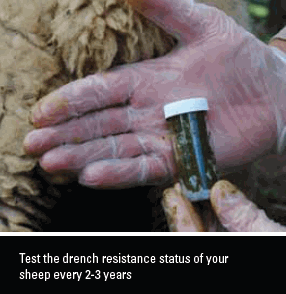|
Drench resistance is widespread in all sheep growing regions of southern Australia. Sheep
producers should test the drench resistance status of their sheep every 2–3 years, depending on
how many drench groups are effective. Drench resistance is generally said to occur if drenches
are less than 95% effective (naphthalophos is one exception). But, in reality, resistance is starting
when efficacy falls below 100%.
A simple worm test 10–14 days after drenching will give a rough indication of drench efficacy,
especially if the worm count at drenching is known. To properly assess drench resistance status
using a worm egg count reduction trial (WECRT), the following guidelines are recommended:
 Select undrenched lambs or weaners (young sheep give the best correlation between worm burden and faecal egg counts) with WEC greater than 250–300 epg. Select undrenched lambs or weaners (young sheep give the best correlation between worm burden and faecal egg counts) with WEC greater than 250–300 epg.
- The number of groups required depends on how many drenches and combinations are being tested. An additional group that remains undrenched is used as a control group. Sheep are randomly allocated to groups and each group clearly identified with either coloured ear tags or a scourable, coloured spray mark. About 15 sheep should be allocated to each group.
Weigh the lambs and calibrate the dose of drench based on the heaviest in each group. Treat each sheep, except those in the control group, then run the sheep as one mob.
Collect faecal samples 10–14 days after drenching from 10 lambs per group. Collect faeces directly out of the rectum. Collect about 5 pellets (5 g) from each sheep into a separate container for each sheep. Exclude air from the top of the container. Mark the sample containers clearly. Keep the samples cool and shaded, but do not refrigerate, and send them to the lab as soon as possible (within 24 hours). Avoid sending samples on Thursday or Friday because they may not reach the lab for several days.
Drench efficacy is calculated by comparing the average WEC of each group with the control WEC. Species efficacy can be compared if larval cultures are done on each group.
Discuss results with your veterinarian or livestock adviser.
Important strategies to minimise drench resistance
- Always drench introduced sheep with 3-4 chemically unrelated actives, e.g. a macrocyclic lactone (ML), white benzimidazole and clear levamisole drench combination — check WEC 10 days after arrival to ensure 100% worm kill (see tool 11.15).
- Test drench efficacy and use effective drenches at critical times, such as summer drenching
- Rotate drench groups, including combinations, to avoid reliance on one group
- Minimise drench frequency, especially in adult sheep
- Drench only after monitoring
- Reduce usage of long-acting drenches pre-lambing
- In most regions, preferably use one summer drench
- Reduce exposure of young sheep to heavily contaminated pasture by:
- 6-monthly swapping sheep and cattle or Smart Grazing (see http://www.wormboss.com.au/) or grazing young sheep on new pastures
- Rotational grazing (>50 days rest) – appears to be very effective at controlling barber's pole, but is less effective for other worms
- Long-term selection for low WEC will help reduce drench frequency (also consider low dag in winter rainfall regions)
- Ensure sheep maintain body condition targets and consider protein supplements for pregnant ewes in summer-rainfall regions. Good nutrition appears to improve sheep resilience and immunity to worms.
- In regions with low worm survival over summer (such as Western Australia), research suggests leaving adult sheep undrenched, provided they are in good condition and appear healthy. This strategy is not recommended for high-rainfall regions where worm larval survival in summer is higher.
|